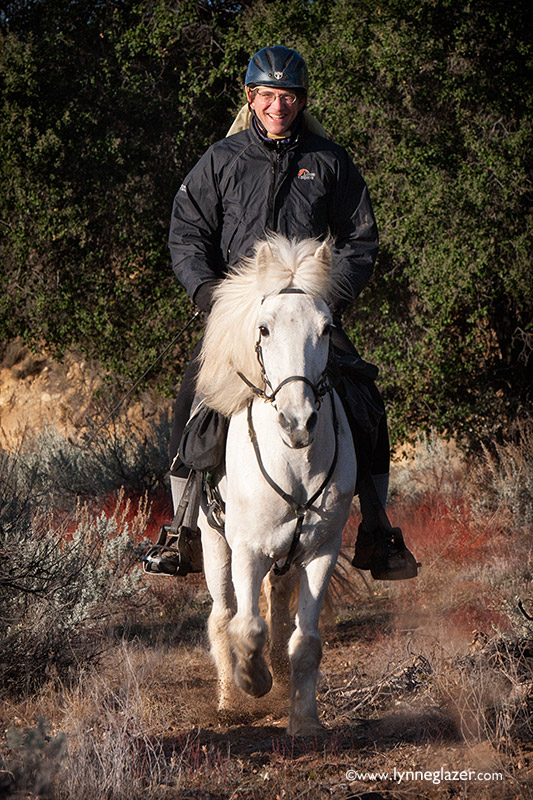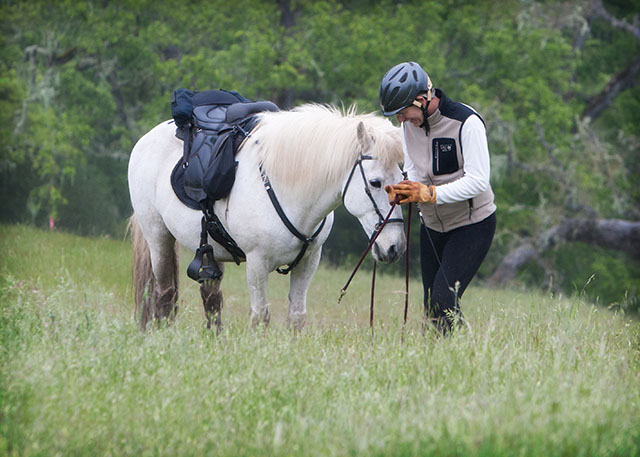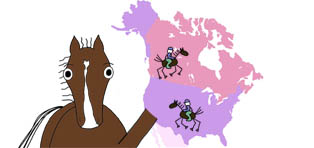
By John Parke
The latest equine inductee into the AERC Hall of Fame is my 26-year-old, 13.3-hand Icelandic horse, Remington. Why on earth would anybody want a cantankerous old pony in the Hall of Fame? Maybe the answer lies in the different ways we recognize endurance in our horses.
What is endurance in a horse? It can be the ability to perform well in a tough 50 or even 100 mile ride. It can also mean the ability to keep competing through a long season and garner year-end awards. Or it can mean the ability to stay sound enough to pile up ride completions over a long career.
Some of the horses in the Hall of Fame have won ride after ride. Others have rolled up mile after mile. Some have done both.
With Remington it is all about longevity. With two 50-mile rides so far this season, we have now completed endurance rides together for the last 20 years in a row. He has accumulated 11,300 career endurance miles so far. He is a gold level horse in the AERC’s 100-mile program for having completed ten 100-mile rides. He has also completed more than ten multiday Pioneer rides.
Even among all the incredible horses in the Hall of Fame, Remington is unique for the combination of these achievements.
Remington hasn’t been pulled since 2004 when he completed 2,055 miles in one season. He is the highest mileage gaited horse in the history of the sport by far. He participated in the XP 2001, XP 2004 and XP 2011 cross-country rides and has crossed the Continental Divide at South Pass three different times.
Whether you prefer the metaphor of the Energizer bunny or the Timex watch which keeps on ticking, the pony just keeps going.
Most people rightly think of Remington and me as back-of-the-pack finishers. Our only top ten finish when there were more than ten horses entered in a ride came in the first AERC 100 Mile Championship Ride in 1998 after other horses dropped out.
Remington did show an occasional turn of speed, though, years ago when I was pushing for him to be the first Icelandic to win a regional points championship. I think his fastest 50-mile time was 5:44 for a ride out in the desert. We went first middleweight in the Pacific Southwest Region in 1998 and again in 2004. It seemed like we were always competing back then with my fellow middleweight Randy Coleman and his superb Hall of Fame horse Pandora’s Pixy. We also took the regional rider mileage championship in both of those years, and placed second in national mileage in 2004.
We started endurance in 1995 just a few months after I bought Remington as a Christmas present for my wife and children the year before. I was an avid mountain biker at the time but thought that riding the pony would be something my whole family could share. I hadn’t ridden a horse for nearly 40 years since back when I would climb up on the back of one of my grandpa’s farm horses with two or three of my cousins when I was a child.
I thought it was only fair to try to keep Remington fit after I brought him home so I tried to ride him a couple of nights a week after I came home from work. His breeder told me that I should give endurance riding a try if I was going to ride him so much. She had done endurance on Icelandics to promote the breed a decade or so before. I also learned about the prominent role Icelandics played in the Great American Horse Race in 1976.
Endurance looked like the perfect sport for us. I figured I would learn a lot about horseback riding and horse care from other riders. We would have the benefit of supervision from veterinarians and ride managers to provide us a margin of safety while we both learned about covering long distances and tough terrain. We would be exposed to state-of-the-art information on horse care and equipment. We would get out on beautiful trails we might not otherwise have access to.

I entered our first ride after seeing an ad in a freebie magazine from the feed store. I was totally clueless about what to do at the ride, but Remington seemed to buzz right along. At the midway vet check, the vet said his trot didn’t look right. Then a gruff voice behind him said, “I vetted those furry things all the way across the country in the Great American Horse Race. That’s a tolt, not a trot. He’s fine.” (That was the beginning of a very long relationship with Dr. Dave Nicholson.)
I still remember the feeling of accomplishment when we finished. For some reason, completing that first 30-mile ride was one of the most satisfying things I had ever done.
Our next ride was a Terry Woolley Howe extravaganza near San Diego. I was so ignorant at the time that I didn’t even have a blanket for Remington when it started to rain the night before the ride. So I went over to the general store next to camp and bought a red-checkered plastic tablecloth and safety pins to use as a makeshift rain fly. We had such a good time the next day at Terry’s perpetual party that I could not imagine not doing it again. I guess we were hooked.
After a season of limited distance rides, we tried our first 50-milers at the beginning of 1996. We completed our first one but just weren’t adequately prepared to finish our second one. I then met up with Kim and Richard Fuess and received excellent mentoring from them on conditioning and nutrition for longer distances. This made a world of difference for us. We completed another half dozen or so 50s with no problem over the rest of the year.
We completed our first 100 the beginning of the next year. We did our first multiday ride six months later when we drove out to Utah with Richard and his young Arabian stallion Jake. It was obvious by then that Remington was never going to be a threat to finish first. It was equally clear, though, that he possessed that extra degree of toughness and soundness to stay fresh over any distance, especially multidays.
I came to realize that completing those longer distances was as much about me having the brain power and discipline to properly manage the horse over the course for hours and hours and even days as it was about the horse himself. Whether it was the scenery or the mental challenge, all of my favorite ride memories over the many years since then have come from 100-milers or multidays.
Remington’s time with the young stallion Jake at multidays illustrates much about the pony’s character. The same qualities that make him a great babysitter can make him a handful to deal with. The plain truth is that he is cranky and willful. He is supremely confident out on the trail, and everywhere else. He is obsessed with keeping other horses in line. Young, nervous horses love being with him. He has helped dozens of them through rides. Remington is the horse everybody waits for to lead the youngsters over difficult stream crossings or through herds of cattle.
Remington’s bossiness extends to other species besides horses. He relishes pushing cattle around. He has no tolerance for dogs. He enjoys the company of people but does not like being told what to do by them. His willingness to run away (but not very far) from anyone trying to hold his lead rope is legendary.
Remington’s aggressive nature can have its advantages. Perhaps my scariest experience riding him came when we surprised a full-grown black bear at close quarters on the aptly named Upper Oso trail in the national forest near my home. Clearly agitated, the bear faced us from less than ten feet away and started to rock from side to side. All I could think about was what would the bear do to me if I fell while my horse spun to run away. Instead, Remington pinned his ears back, arched his neck and charged. The bear, at least, had the good sense to turn around and run down the mountain.
I suppose Remington even has a protective or gentle side to his personality. The only other person besides me to ride him in an endurance ride was my youngest son, back when my son was 12 years old. My son has special needs but he wanted to try to get through an endurance ride at least once in his life.
Remington carried him as though he was bearing the most precious, most fragile cargo in the world. For once, he stood perfectly still for every mount and dismount. Whenever my son would stretch, Remington would gradually slow and give him time to get comfortable. Remington stayed perfectly balanced underneath him for 50 miles, with no sudden movements.
Tears still well in my eyes when I think of my son’s pride when they crossed the finish line and my gratitude for the priceless gift Remington gave us that day.
Remington’s extreme intelligence and insistence on being the decision maker certainly makes for an interesting ride since I am never sure of what he is going to do. He is nimble and sure-footed. He loves to dash through the rocks and jump over logs and washouts. It is thrilling to ride him while he weaves his way through the trees down a steep winding trail in the mountains at full speed.
He prefers to pick out the trail himself and is an expert at following ribbons. He has an amazing ability to memorize trail and terrain. He never fails to recognize a trail even in country he has traveled through only once or twice and hasn’t seen for years.
Any discussion of Remington’s behavior on the trail invariably turns to his gait, as in what is it? He actually has a flashy four-beat tolt when you make him do it but that is not the two-beat gait I hear on the trail. I assumed for years that his predominant gait was the trot. Endurance riders who rode a lot of miles with me would tell me that it didn’t look exactly like a trot to them. Trilby Pedersen used to call it his “little shuffle.”
So recently I got out all my old ride photos and researched books and articles on gaits. The photos of Remington’s side gait tell all. I cannot find one photo of him showing the classic diagonal stride and even footfall of a trot. Instead, what the photos consistently show is when the hind leg is touching down underneath him, the front leg on the same side is up in front of his chest with the foot hanging down. While the other hind leg is extended behind him, the front leg on that side is in a near vertical position under him instead of reaching out as it would be in a trot.
If I listen carefully, what I hear isn’t really a two-beat gait but a broken four-beat gait instead. I don’t hear the even four-beat “Black and Decker” sound of a proper tolt. I hear a “di-dut, di-dut” instead. Photos show his front feet are clearly touching and taking off before his corresponding hind feet. His hoof marks show a nine-inch overstride. Whatever it is, the gait is very, very smooth to ride at any speed. Methinks my pony dances the foxtrot!
Whatever way he is going, my strange little horse is still going strong. He hasn’t had a step of lameness since he started going barefoot several years ago. He has actually muscled up and become more powerful since I switched to a treeless saddle at about the same time.
I have been riding Remington now for exactly half of my adult life. The pressures of maintaining a busy law practice and caring for a now-adult special needs child never seem to leave me with enough time for riding. Still, we make do. Although my wife is my true love, Remington is definitely my soulmate. When we are riding in the wee hours of the morning, I can feel his muscles moving as though they are my own and I know he can read my thoughts. Sometimes it feels like we are two parts of the same being.
I was filled with pride when Remington was awarded Hall of Fame horse at the AERC national awards banquet this year. It was especially meaningful that the award was presented by our longtime friend Terry Woolley Howe, because she has witnessed our entire endurance riding career. Oddly, I wasn’t proud for my horse, because I already knew who he is and what he has accomplished. No, what I was proud of was my AERC.
I was proud of my AERC because it recognizes the value of keeping our horses sound and healthy over the miles and over the years. I was proud of my AERC for sticking to its guns and staying at the forefront of guarding our horses’ welfare for the 20 years Remington and I have been in the sport. I remain proud of my fellow endurance riders for creating a community centered around a profound respect for what our horses do for us.
Reprinted from the August 2014 issue of Endurance News, official publication of the nonprofit American Endurance Ride Conference, www.aerc.org, 866-271-2372
Lynne Glazer photos

No comments:
Post a Comment